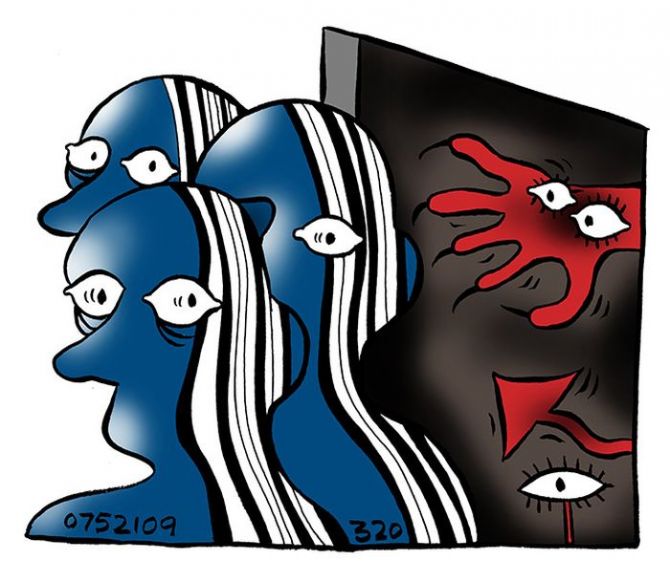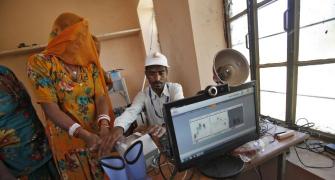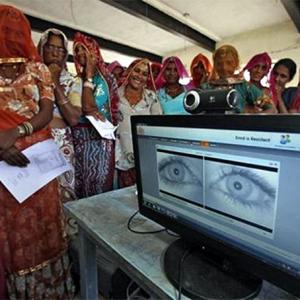Justice Bobde underlines that the 'Arthashastra prohibits entry into others' house, without the owner’s consent’.
He also observes that, 'In Christianity, we find the aspiration to live without interfering in the affairs of others in the text of the Bible', while the Hadith 'makes it reprehensible to read correspondence between others', writes Gopal Krishna.
The third in a 7-part series.
Illustration: Dominic Xavier/Rediff.com.

In his 40-page order as part of the unanimous verdict on Right to Privacy, Justice S A Bobde made it absolutely and unambiguously clear that the judgment has been delivered 'in the context of a constitutional challenge to the Aadhaar project, which aims to build a database of personal identity and biometric information covering every Indian -- the world's largest endeavour of its kind'.
He was referring to the Central Identities Data Repository of biometric data-based 12-digit Unique Identification or Aadhaar numbers of residents of India, who have lived in India for at least 182 days after September 12, 2016, when Aadhaar Act, 2016 came into force and those residents who lived even for a single day as a resident prior to that date.
Justice Bobde had inadvertently assumed that this project is ‘covering every Indian’.
The fact is that it is covering every defined ‘resident’ of India and every undefined ‘resident’ prior to a specified date. As per the Aadhaar Act, it means that the CIDR of residents of India is a universal set and ‘Indians’, citizens of India, who come under it are its subset.
As per the gazette notification from the ministry of electronics and information technology, ‘In exercise of the powers conferred by sub-section (3) of Section 1 of the Aadhaar (Targeted Delivery of Financial and Other Subsidies, Benefits and Services) Act, 2016 (18 of 2016), the central government’ appointed ‘the 12th day of September 2016, as the date on which the provisions of Sections 1 to 10 and 24 to 47 of the said act shall come into force’.
This Act of Parliament had received the assent of the President on March 25, 2016.
As a consequence, definition of resident provided in Section 2(v) of the Act too came into force. As per this sub-section, ‘resident’ means an individual who has resided in India for a period or periods amounting in all to 182 days or more in the 12 months immediately preceding the date of application for enrolment’.
A release from the ministry of communications, dated April 4, 2016, announced that the Unique Identification Authority of India ‘has generated the 100th crore Aadhaar’ on that day, touching the landmark in a span of five-and-a-half years since the first Aadhaar was issued in 2010.
‘This comes just a few days after a historic legislation Aadhaar (Targeted Delivery of Financial and Other Subsidies, Benefits, and Services) Act 2016 has been notified by the government,’ it said.
The release was jubilantly claiming it to be a ‘historic moment for India’ and ‘indeed a momentous occasion’.
It claimed that the UIDAI ‘authenticates over 40 lakh transactions per day’.
It also claimed that over 150.6 crore authentication transactions have been done by the UIDAI.
These claims reveal that, admittedly, 100 crore people who were enrolled for Aadhaar were not ‘residents’ of India as per the definition under the Act. Does it not mean that all those who got themselves enrolled for Aadhaar number prior to September 12, 2016, are not ‘residents’ as per the Act?
At some point, the 37,304 enrolment stations manned by 3,76,543 certified operators spread across the country may have been informed about the need for enrolling only the defined ‘residents’ after having enrolled 100 crore people of South Asia and elsewhere.
Notably, out of these, 34,000 operators have been blacklisted for trying to make fake Aadhaar, which is about 10 per cent of all (3,76,543) operators.
It may be recalled that the first Aadhaar numbers were given to the villagers of Tembhali village in Nandurbar district of Maharashtra on September 29, 2010, by former Prime Minister Dr Manmohan Singh, who said that ‘the Aadhaar number will ease these difficulties in identification, by providing a nationally valid and verifiable single source of identity proof. The UIDAI will ensure the uniqueness of the Aadhaar numbers through the use of biometric attributes (finger prints and iris) which will be linked to the number’.
This shows how Indians were taken for a ride because neither the first woman who was issued Aadhaar is a defined ‘resident’ nor the 100th crore one. This makes the 100 crore moment of enrolment dubious and questionable.
Justice Bobde records in his order, ‘To the petitioners’ argument therein that Aadhaar would violate the Right to Privacy, the Union of India, through its attorney general, raised the objection that Indians could claim no constitutional right of privacy…..’
This observation makes it unambiguously clear that the verdict of the Constitution Bench has found no merit in attorney general of India’s ‘objection that Indians could claim no constitutional right of privacy’ made to continue with the implementation of CIDR of Aadhaar number project.
This makes the constitutional basis of attorney general for promoting the project dubious and questionable too.
It is noteworthy that the case against the CIDR of Aadhaar number project was filed on October 18, 2012, and registered on November 10, 2012.
This first petition stated that ‘collecting biometric information as a condition precedent for the issue of Aadhaar number is an invasion of the right to privacy of citizens’.
It submitted that the Aadhaar number is being issued to a non-citizen on the ground that he is residing in this country.
As a consequence ‘he becomes entitled to the Fundamental Rights guaranteed under Article 14 and 21 of the Constitution as Fundamental Rights under Article 14 and 21 are available to all persons in India and consequently also right to a remedy under Article 32 of the Constitution’.
It also submitted ‘it is a matter of great security concern for the nation also’.
The first order against the Aadhaar project was issued on September 23, 2013.
Justice Bobde was part of the first division bench that heard the matter along with Justice Dr B S Chauhan, who is currently the chairman of the 21st Law Commission of India.
Since then, more than 20 cases have been filed in the court seeking scrapping of the CIDR of Aadhaar project and Aadhaar Act, 2016.
Notably, Justice Bobde was part of the original three-judge bench that had referred the matter to a Constitution Bench of ‘appropriate strength’.
Part 1: Right to Privacy and the Bhagavad Gita
Part 2: How Aadhaar promotes a digital caste system
He was also part of the five-judge Constitution Bench that referred the issue of Right to Privacy to the nine-judge Constitution Bench.
He underlined that ‘the question, which was framed by a bench of three of us’ in August 2015 was reiterated by ‘a bench of five’. This led to the setting up of the nine-judge Constitution Bench, which conceived and delivered the right to privacy verdict to safeguard ‘the very concept of civilisation’.
Taking note of decisions in an unbroken line of at least 30 cases affirming the existence of a constitutional right to privacy, Justice Bobde expressed his concurrence with the opinions of Justices J Chelameswar, Justice Rohinton F Nariman and Justice D Y Chandrachud.
Recognising the existence of ‘the State, a new actor with an unprecedented capacity to interfere with natural and common law rights alike’, the State as ‘an abstract and diffuse entity’ and citizens as ‘agents of political power qua the state’, he observes that ‘Preambular ‘people of India’ -- create ‘the State’, a new entity to serve their interests and be accountable to them, and transfer a part of their sovereignty to it’.
But he underlines ‘the rise of the new political hegemon’ and ‘new peril of a diffuse and formless entity against whom existing remedies’ which has traditionally been adopted ‘are no longer efficacious’.
Justice Bobde refers to Jurisprudence of Roscoe Pound -- which has been cited in the verdict in Kesavananda Bharati v State of Kerala (1973) -- who, while dealing with natural rights, says, ‘Perhaps nothing contributed so much to create and foster hostility to courts and law and constitutions as this conception of the courts as guardians of individual natural rights against the State and against society; this conceiving of the law as a final and absolute body of doctrine declaring these individual natural rights…..as a super-constitution, beyond the reach of any agency but judicial decision’.
He takes note of individuals who could be ‘spied upon’ facing interference with Fundamental Rights by the State or any other similar entity recognised by Article 12 of the Constitution or by ‘individuals clothed with the powers of the State’.
Significantly, he observes that privacy ‘must also mean the effective guarantee of a zone of internal freedom in which to think’ and goes on to infer that ‘expressive freedoms guaranteed by the Constitution depends on the existence of a corresponding guarantee of cognitive freedom’.
It is of immense value that these observations are being made in the course of the deliberations on the reference that emerged from the Aadhaar case.
Justice Bobde underlines that the ‘Arthashastraprohibits entry into others' house, without the owner’s consent’. (Kautilya's Arthashastra is a highly regarded text of 3rd century BC.)
It is noteworthy that Kautilya Unleashed, a modern look at Arthashastra by C T William, has identified two key principles from this text, namely, acquisition of resources and retention of acquired resources.
It is germane to recollect that both the principles are relevant to the acquisition and retention of biometric information underway in the name of creating ‘the largest online digital identity platform in the world’.
‘Biometrics Design Standards for UID Applications’ prepared by UIDAI’s Committee on Biometrics states in its recommendations that ‘biometrics data are national assets and must be preserved in their original quality’.
Notably, these very ‘national assets’ and resources have been acquired by foreign companies as per the contract agreements between the UIDAI, as purchaser and L-1 Identity Solutions Operating Company, and Accenture Services Pvt Ltd. Outrageous facts revealed by the Right to Information queries.
At clause 15.1 of the contract it is stated, ‘By virtue of this Ccontract, M/s Accenture Services Pvt Ltd/Team of M/s Accenture Services Pvt Ltd may have access to personal information of the purchaser and/or a third party or any resident of India, any other person covered within the ambit of any legislation as may be applicable’.
The purchaser is President of India through UIDAI.
Clause 15.3 of the agreements reads, ‘The data shall be retained by Accenture Services Pvt Ltd (for) not more than a period of seven years as per retention policy of (the) government of India or any other policy that (the) UIDAI may adopt in future’.
This clearly implies that all the biometric data of Indians which has been collected so far is now available to the United States government and the French government.
Accenture is a US-based company. L1 used to be a US company but got bought over by Safran Group of France.
Similar contract has been signed with Ernst & Young. These documents have been accessed using RTI.
Justice Bobde observes, ‘In Islam, peeping into others’ houses is strictly prohibited’ and added, ‘the Hadith makes it reprehensible to read correspondence between others’.
The CIDR facilitates peeping into others’ houses.
Notably, J Satyanarayana as secretary, department of electronics and information technology [DeitY] (currently named ministry of electronics and information technology) finds mention at page no 46-47 of the report of Parliamentary Standing Committee on Information Technology that examined the work of his department.
He was asked about the surveillance by National Security Agency of the US.
The report states that in the context of privacy of data, the committee desired to know the department’s stand on the issue of surveillance by the US and interception of data sent through e-mails.
To this, Satyanarayana, as secretary, DeitY, responded as under: ‘Sir, about the US surveillance issue, there has been a debate, as you are aware, this morning in the Rajya Sabha itself and the hon’ble minister has addressed this issue. He also emphasised that as far as the government data and government mails are concerned, the policy, the copy of which I have given to the committee earlier, is going to address a large part of it.
‘Hopefully, by the end of this year, if it is implemented, the things will be absolutely safe and secure…In the reply the Hon minister also said that we have expressed our serious concern about the reported leakages and in the name of surveillance, the data that has been secured from various private sources, internet resources by the US government.
‘We have expressed it formally to the government of the US and also, during the secretary of state’s visit a few weeks ago in India, this has been reinforced on a person to person basis.’
He added, ‘We have been assured that whatever data has been gathered by them for surveillance relates only to the metadata. It has been reiterated and stated at the highest level of the US president that that only the metadata has been accessed, which is, the origin of the message and the receiving point, the destination and the route through which it has gone, but not the actual content itself.
‘This has been reiterated by them, but we expressed that any incursion into the content will not be tolerated and is not tolerable from Indian stand and point of view. That has been mentioned very clearly and firmly by our government.’
In effect, the Government of India has formally communicated to the government of the US that India has no problem if they conduct surveillance for metadata. In fact it is acceptable and tolerable but ‘incursion into the content will not be tolerated and is not tolerable’.
It is reprehensible even to collate metadata. Metadata refers to all the information about a communication except content.
An Urdu couplet -- hum woh hai jo khat ka mazmoon bhaap lete hai lifafa dekhkar (we are those who can assess the content of letter by merely looking at the envelope) captures the message from the US and which the political class in general has missed.
Such faith in the government of US' empty words is inexcusable and indefensible.
The same Satyanarayana is currently part-time chairman of the UIDAI since September 6, 2016.
Justice Bobde observes, ‘In Christianity, we find the aspiration to live without interfering in the affairs of others in the text of the Bible. Confession of one’s sins is a private act’.
The reference to Bible in the case is of immense significance because it pertains to numbering of human beings in the Indian Territory that finds specific mention in the Bible.
The Number of the Beast is a term in the Book of Revelation of the New Testament.
Revelation chapter 14 states that whoever receives the mark of the Beast, ‘shall drink of the wine of the wrath of God’.
The mark is a permanent designation of ownership applied to your forehead or right hand. The Biblical prophecy implies that there will be a time when humanity will be forced to take a mark, and that mark will be on the right hand or the forehead.
It has been contended that marriage of biometric and digital identification will be the mark of the beast because it can be a mark in your hand that you can transmit.
Fortunately, the beast gets killed in the end.
Among several other arguments, this Biblical prophecy has been used to oppose REAL ID Act in 2005 introduced during George W Bush era.
The US Senate never discussed or voted on the REAL ID Act specifically and no Senate committee hearings were conducted on the Act prior to its passage, exposing its undemocratic character and the bill's proponents avoided a substantive debate on a far-reaching piece of legislation by attaching it to a ‘must-pass’ bill.
Barack Obama categorically opposed it during his 2008 presidential election campaign.
By 2008, all 50 states had either applied for extensions of the original May 11, 2008, compliance deadline or received unsolicited extensions.
Some 25 states from the US have approved either resolutions or binding legislations not to participate in the programme. Among other concerns, they have argued that it infringes upon states’ rights.
With Janet Napolitano, a prominent critic of the programme as the head of US Department of Homeland Security, the future of the law appears sealed.
On March 5, 2011, the DHS postponed the effective date of the REAL ID Act.
Through Document Number FR 5-08, DHS announced that US states would need to be in compliance with the REAL ID Act by December 1, 2017. Bills have been introduced into US Congress to amend or repeal it.
The controversial, $4-billion REAL ID initiative was meant to provide secure licences in the hands of 245 million Americans by 2017. The new proposal, Providing for Additional Security in States’ Identification (PASS ID) Act was expected to eliminate many of the more burdensome technological requirements.
The Bill was meant to repeal title II of the REAL ID Act of 2005 and amend title II of the Homeland Security Act, 2002, to better protect the security, confidentiality, and integrity of personally identifiable information collected by states when issuing driver’s licences and identification documents, and for other purposes.
It is surprising as to why the government of India, which has been keen on emulating REAL ID Act when it was adopted in the US, has developed cold feet in following the same example when it is practically abandoned there.
Justice Bobde concludes by saying, ‘Any interference with privacy by an entity covered by Article 12’s description of the ‘State’ must satisfy the tests applicable to whichever one or more of the Part III freedoms the interference affects’.
It emerges that not only does the CIDR project fails the test of fairness, justness and reasonableness besides the test of not being fanciful, oppressive or arbitrary; it also fails the test of Arthashastra, Hadith and the Bible.
Part IV in the series: Aadhar Act contravenes right to life and liberty
Gopal Krishna is convener, Citizens Forum for Civil Liberties, which is campaigning against surveillance technologies since 2010.










